BUNRAKU (or NINGYO JORURI)
Edit: Pics are up now! Enjoy!
Ok So here’s the Puppet Show Post!
Last Thursday I was given the opportunity to go to a Bunraku or Traditional Japanese Puppet Show. The show was one stop past Odori park in Sapporo’s Old Town. The cost for one person I heard was roughly $50 usd for each ticket, however the school picked up the tab. (Thanks!)  There is a bit of humor to all of this, due to the fact that when I was trying to tell my host family I’d be going to a Bunraku performance; they didn’t know what on earth Bunraku was. They had never been to bunraku, kabuki, or a noh performance before and they’re Japanese! Not to worry, I’m sure there’s something I haven’t done in America before… … …but I can’t think of it yet.
There is a bit of humor to all of this, due to the fact that when I was trying to tell my host family I’d be going to a Bunraku performance; they didn’t know what on earth Bunraku was. They had never been to bunraku, kabuki, or a noh performance before and they’re Japanese! Not to worry, I’m sure there’s something I haven’t done in America before… … …but I can’t think of it yet.
We went by subway. We started in Oyachi and got off at the station after Odori (the name I forget). The theater was located in a giant park. As we headed in, we were all given tickets with our seat number (ex. 2ね8) and we’re seated accordingly. The “ne” in 2ne8 is just the order we were seated in according to the Japanese hiragana alphabet (あ、か、さ、た、なーね). After being seated we waited for the play to begin. No one really knew what was about to happen, because no one in our group (Japanese included) had ever been to one.
If you don’t know officially what Bunraku is… here’s a great description from the Japan Art Council :
 Bunraku is the traditional puppet theatre of Japan, a high-level stage art of which
Bunraku is the traditional puppet theatre of Japan, a high-level stage art of which 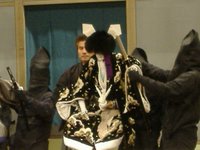 Bunraku’s world renown stems not only from its high-quality artistic technique, but also from the high level of its joruri music and the unique nature of manipulating the puppets―each puppet requires three puppeteers to bring it to life. Throughout the world there are a number of types of puppet theatre, and they all treat with simple stories such as myths and legends. There is no other art that requires a whole day for its long, serious drama to unfold.
Bunraku’s world renown stems not only from its high-quality artistic technique, but also from the high level of its joruri music and the unique nature of manipulating the puppets―each puppet requires three puppeteers to bring it to life. Throughout the world there are a number of types of puppet theatre, and they all treat with simple stories such as myths and legends. There is no other art that requires a whole day for its long, serious drama to unfold. 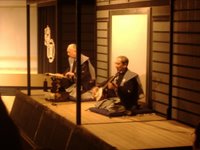 Furthermore, in most of the world’s puppet theatres, great pains have been taken to hide the manipulation of the puppeteers from the audience. There are several methods of achieving this: suspending the puppet from strings attached to the ceiling, as with marionettes; placing a hand within the puppet and moving it with the fingers, as with guignol puppets; and casting shadows upon a screen, as with the wayan kulit shadow puppets. But in Bunraku, the manipulators appear openly, in full view of the audience. These two characteristics, which make it completely different from the other puppet theatre traditions around the world, can be said to be the reason that Bunraku is called the most highly developed puppet theatre art in the world.
Furthermore, in most of the world’s puppet theatres, great pains have been taken to hide the manipulation of the puppeteers from the audience. There are several methods of achieving this: suspending the puppet from strings attached to the ceiling, as with marionettes; placing a hand within the puppet and moving it with the fingers, as with guignol puppets; and casting shadows upon a screen, as with the wayan kulit shadow puppets. But in Bunraku, the manipulators appear openly, in full view of the audience. These two characteristics, which make it completely different from the other puppet theatre traditions around the world, can be said to be the reason that Bunraku is called the most highly developed puppet theatre art in the world.
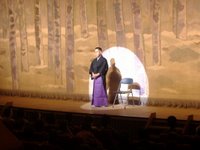 I don’t know if this is what we actually experienced, but it was a highly sophisticated puppet show. The show began with a man walking to the stage and giving us a history lession on bunraku. This informational was of course in Japanese, in fact it was all in Japanese. He basically said where it was started and the elements of Bunraku and such and then he left. The next guy that showed up was the narrator who gave a speech on the elements of narrorating both the guy and gal’s voices. In bunraku, there is no women at all so the narrator has to do both man and women’s voices. The skill involved is intense and is taught the same way as the age old Master to Apprentice.
I don’t know if this is what we actually experienced, but it was a highly sophisticated puppet show. The show began with a man walking to the stage and giving us a history lession on bunraku. This informational was of course in Japanese, in fact it was all in Japanese. He basically said where it was started and the elements of Bunraku and such and then he left. The next guy that showed up was the narrator who gave a speech on the elements of narrorating both the guy and gal’s voices. In bunraku, there is no women at all so the narrator has to do both man and women’s voices. The skill involved is intense and is taught the same way as the age old Master to Apprentice.
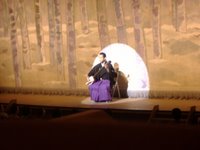 The next guy to enter the stage was the shaminsen guy who gave examples of playing and beats and assisting the narrator. He showed the audience all the parts of the Shaminsen and how he learned how to play the 3 stringed instrument. A note on Shaminsen is that it uses friction pegs so sometimes it goes out of tune, but honestly I wouldn’t know if it was out of tune or in tune.
The next guy to enter the stage was the shaminsen guy who gave examples of playing and beats and assisting the narrator. He showed the audience all the parts of the Shaminsen and how he learned how to play the 3 stringed instrument. A note on Shaminsen is that it uses friction pegs so sometimes it goes out of tune, but honestly I wouldn’t know if it was out of tune or in tune.
The Last guy came out with two other assistances who helped him with a large female puppet. This was the Puppeteer who demonstrated the skills of making a puppet come to life.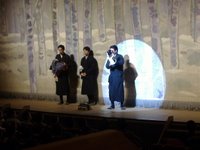 The examples he showed the audience were facinating to say the least. The way he moved it made it come to life, not like puppets on Mr. Rodgers. This was just awesome how it made it bend and turn and bow like we do. The whole performance was performed in this masterful way that at times made you forget about the puppeteer and just imagine the puppets as people. Culturally, the main Puppeteer wears a white robe with a black robe over it. His head is exposed and he often makes the expressions his puppet makes in order to consume himself and the audience with realism. The other assistances however wear black robes with face masks so that only the puppet and the puppeteer is exposed. It’s like any staff person at a show, concert, or public hall wears a black outfit to “disapear” so to speak.
The examples he showed the audience were facinating to say the least. The way he moved it made it come to life, not like puppets on Mr. Rodgers. This was just awesome how it made it bend and turn and bow like we do. The whole performance was performed in this masterful way that at times made you forget about the puppeteer and just imagine the puppets as people. Culturally, the main Puppeteer wears a white robe with a black robe over it. His head is exposed and he often makes the expressions his puppet makes in order to consume himself and the audience with realism. The other assistances however wear black robes with face masks so that only the puppet and the puppeteer is exposed. It’s like any staff person at a show, concert, or public hall wears a black outfit to “disapear” so to speak.
When he left the performance began and the curtin went up. It was 1pm and we didn’t get outta there until 4:30pm. The performance was awesome, I’m sure it’d be better if I knew what was going on, but I didn’t. Not sure what I was seeing, I liked the outfits and the characters and shaminsens and stuff. My friend and I went and took some snap shots of the play, although I heard afterwards that pictures may not of been allowed. “Oh well” I say… sometimes it’s easier to appologize then to ask permission, right? Plus, it’s not about me anyway… it’s about you all!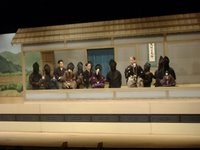
To review the entire performance would be crazy! I’ll say it was equally cool as it was boring. Most of us might of dozed off for the slow scenes, but woke up to the cool scenes. I’ll admit I was bored so instead of dozing, I took pictures… lots and lots of pictures (about 101 pics and short movies). Overall it was a good experience and a look at what Japan has to offer.
~J out